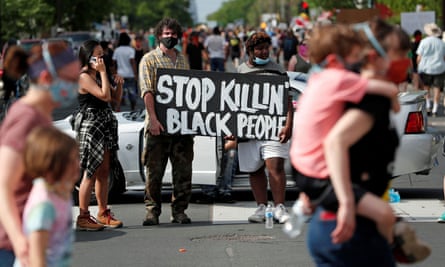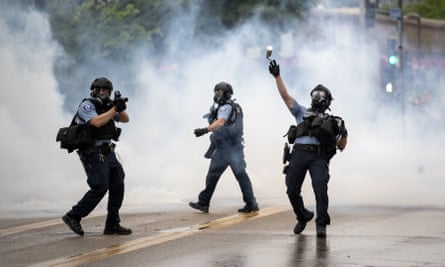George Floyd killing: what sparked the protests – and what has been the response? (original) (raw)
The US is undergoing a reckoning on race and police brutality after footage went viral of a white police officer killing a black man by kneeling on his neck for more than eight minutes.
Protests have flared up across the country as people demand the arrest of the officers involved in the killing and for systemic change that will put an end to police brutality. After clashes with the police on Wednesday, some protesters set buildings on fire and ransacked stores. Here’s what we know so far.
What prompted the protests?
Protests erupted on Tuesday in Minneapolis, Minnesota, after word got out that George Floyd, 46, a black man, was killed in police custody on Monday night after Derek Chauvin, a white police officer, knelt on his neck.
The officers were responding to a call from a grocery store that claimed Floyd used a fake $20 bill. Police said he “physically resisted officers” once police located him inside his car.
In graphic footage of the incident shared on social media, Floyd can be heard shouting “I can’t breathe” and “Don’t kill me!” as the officer continues to kneel on his neck until medical personnel arrive. On Tuesday, the Minneapolis police department confirmed that he died “a short time” after a “medical incident” once he was transported to hospital.
Floyd’s family and friends called him a “gentle giant” because he was tall with a “quiet personality but a beautiful spirit”. The father of a six-year-old daughter had recently been laid off from his job as a bouncer at a local restaurant.
Have any arrests been made?
Chauvin was arrested on Friday afternoon on charges of third-degree murder and second-degree manslaughter.
According to the complaint filed by the county prosecutor against Chauvin, Chauvin had his knee on Floyd’s neck for eight minutes and 46 seconds total, two minutes and 43 seconds of which Floyd was unresponsive. “Police are trained that this type of restraint with a subject in a prone position is inherently dangerous,” the complaint said.
The complaint also said that the autopsy of Floyd revealed “no physical findings that support a diagnosis of traumatic asphyxia or strangulation”. Rather, the “combined effect of Floyd being restrained by the police, his underlying health conditions and any potential intoxicants in his system likely contributed to his death”. The family plans a second, independent autopsy.
The arrest came four days after the incident. The officers were fired on Tuesday.
What other incidents sparked the protests?
The police killing of George Floyd comes on the back of two other high-profile killings of black Americans in recent weeks.
Video footage of the murder of Ahmaud Arbery, 25, from 23 February began circulating in early May. Arbery was jogging through a neighborhood outside Brunswick, Georgia, when he was shot dead by two white men, a 64-year-old father and his 34-year-old son, in a pickup truck who were pursuing him. The men were charged with murder and aggravated assault and arrested on 7 May after footage of the incident went viral.

Protesters gather at the scene where George Floyd was pinned down by a police officer kneeling on his neck in Minneapolis, Minnesota, on 26 May. Photograph: Eric Miller/Reuters
Just a few weeks after Arbery died, Breonna Taylor, a 26-year-old certified EMT, was killed in her bed at home by police officers who were serving a “no-knock” warrant for a narcotics investigation on 13 March.
Taylor’s boyfriend, Kenneth Walker, said he believed he was witnessing a home invasion when police broke down their apartment door. Walker picked up his gun and fired a shot that hit an officer in the leg. In response, officers fired more than 20 times. Taylor was hit eight times and killed.
Where are the protests?
Protests have taken place all around the US, as they have since news of Arbery’s murder began to spread earlier in May.
The killing of Floyd was a tipping point. The largest demonstrations have been in the Twin Cities, Minneapolis and St Paul, where peaceful protests have turned into riots in places, following clashes with police. Other protests have taken place in Denver, Chicago, Oakland, Los Angeles, Columbus, and New York.

A police officer throws a teargas canister towards protesters in Minneapolis, Minnesota, on 26 May. Photograph: Carlos Gonzalez/AP
What’s been happening during the protests?
“I can’t breathe” has become the rallying cry for demonstrators, bringing back a phrase that was used in protests around the police killing of Eric Garner in New York City in 2014.
In Minneapolis, hundreds marched on Wednesday from the site of the confrontation between the police officer and Floyd to the police precinct where the officer was based.
When the protest reached the police precinct, officers dressed in riot gear clashed with demonstrators. Videos showed protesters throwing rocks and bottles at police vehicles and police officers using teargas, smoke and flash bombs and rubber bullets.
On Thursday, looting began in parts of Minneapolis and St Paul.
On Thursday night, demonstrators set ablaze the police precinct in Minneapolis .
Protests spread across the country on Friday, with demonstrators clashing with police in New York, Washington and Atlanta. Highways were blocked by protesters in California and the White House was temporarily placed under lockdown. The most violent scenes were in Atlanta, where protesters set a police car ablaze and broke windows at CNN’s headquarters.
In Minneapolis, protesters defied a curfew of 8pm and, despite waves of teargas fired by police, took control again of the police precinct building.
Minneapolis police precinct set ablaze during George Floyd protest – video
What has the response to the protests been?
Just past midnight on Friday morning, Donald Trump tweeted that he sent the national guard to combat the protests in Minneapolis, criticizing the city’s “radical leftist” leaders and threatening a crackdown against demonstrators. “When the looting starts, the shooting starts,” the president wrote in a tweet that has since been hidden by Twitter for “glorifying violence”.
Local leaders have denounced calls for violence against protesters. But in a press conference on Friday, Minnesota’s governor, Tim Walz, said that restoring order was crucial to begin repairing societal injustices.
“The ashes are symbolic of decades and generations of pain and anguish unheard,” Walz said. “George Floyd’s death should lead to justice and systemic change, not more death and destruction.”
Floyd’s family “told me they want peace in Minneapolis, but they know that black people want peace in their souls and that until we get #JusticeForFloyd there will be no peace,” the family’s lawyer, Ben Crump, said in a statement. “We also cannot sink to the level of our oppressors and endanger each other as we respond to the necessary urge to raise our voices in unison and outrage.”